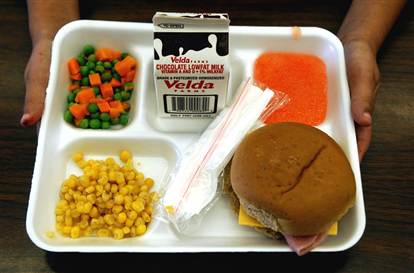As shown in previous pages, there are many problems in how and what types of food children consume. Schools do not know how to deal with new nutritional standards, between providing adequately healthy meals and affordable prices. Food deserts and swamps limit children’s access to healthy foods in many communities. Moreover, food advertisers are fundamentally changing the way kids think about food and consumption.
All of these problems boil down to the same essential question: What do we, our communities, and our society consider to be “good food”?
Misunderstandings Today About Food
 The notion of adequate in food and meals in schools today is very much utilitarian. Lunch is seen as a bodily necessity, or a distraction for children over a lunch hour. This arguably stems from the roots of the National School Lunch Program in a factory model.
The notion of adequate in food and meals in schools today is very much utilitarian. Lunch is seen as a bodily necessity, or a distraction for children over a lunch hour. This arguably stems from the roots of the National School Lunch Program in a factory model.
However, certain practices around school lunches today still reflect this mindset. The median time students are given to eat is thirty minutes in middle and high school, and as little as twenty minutes in some schools. Moreover, in educational reform policies food is not often considered. Education funding is often directed towards structural policies (teacher education, achievement testing, etc.), not food. Oftentimes, stereotypes of school meals are vilified into being of poor quality. Perhaps most striking, there is a “McDonaldization” of school cafeterias today. In 2009, 35.5% of US schools offered fast food branded fare, with Domino’s pizza being served in 26% of all US school districts.
Not only does the quality of school food affect students’ health, teachers’ health, and arguably students’ academic achievements, but it offers a window into how society views food. Food, especially school food, is political in nature. A school meal represents a governmental ideology on how children should be fed.
Alternative Ways of Looking at “Good Food”
“Whatever the relative weight of food in a study, it is time to take school food seriously, to consider how much depends on this most human, embodied part of the school day.” – Weaver-Hightower, “Why Education Researchers Should Take School Food Seriously”
Food and meals are a cultural, political, and overall human experience. Children are often stressed in schools and in their community that food is something to be consumed quickly and efficiently. However, if we consider food as something to be savored, and meals to be enjoyed, then we define “good food” differently. This is the sort of mindset that has been missing in how we feed kids, and may just be the key to feeding kids well.
Information:
http://0-www.jstor.org.luna.wellesley.edu/stable/41058190?
http://link.springer.com/article/10.1007%2Fs10460-006-9019-z
http://www.nature.com/ejcn/journal/v57/n1s/full/1601824a.html
http://0-www.jstor.org.luna.wellesley.edu/stable/25762964?
Images:
http://gezellig-girl.com/2011/02/04/school-lunches-part-3/
http://usatoday30.usatoday.com/news/health/2004-05-11-vending-machines_x.htm
http://www.urbanmamas.com/childcare/2011/08/new-day-school-vegan-preschool-.html

